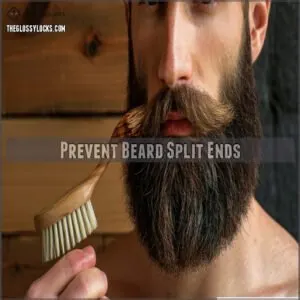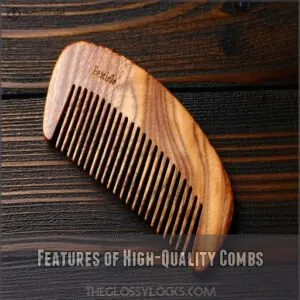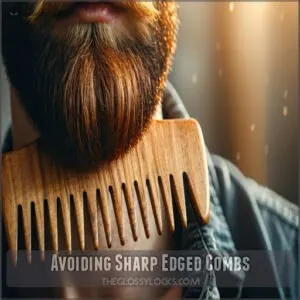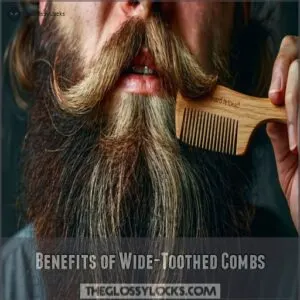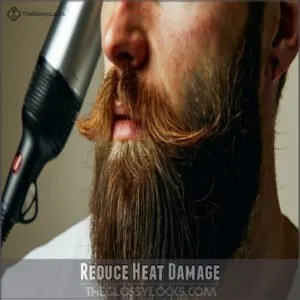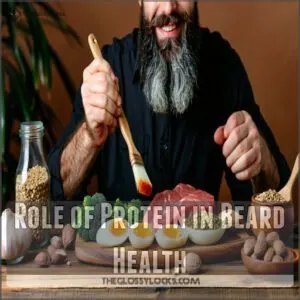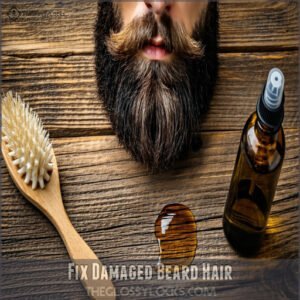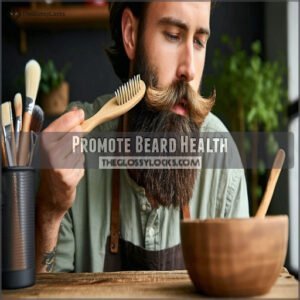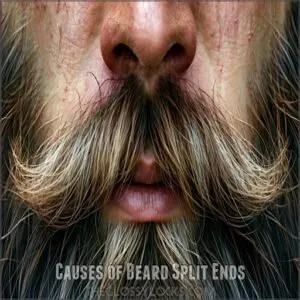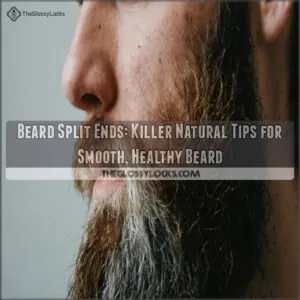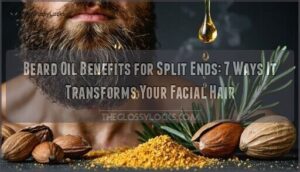This site is supported by our readers. We may earn a commission, at no cost to you, if you purchase through links.
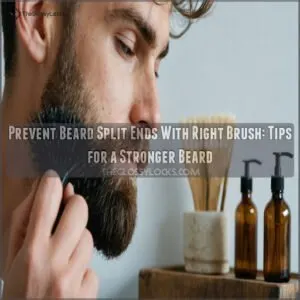 To prevent beard split ends with the right brush, start with a soft-bristled beard brush—your beard’s best friend.
To prevent beard split ends with the right brush, start with a soft-bristled beard brush—your beard’s best friend.
It evenly spreads your natural oils, keeping hair hydrated and protected. Use gentle strokes, beginning at the ends and moving upward.
Think of brushing as a mini spa session for your beard, not a tug-of-war! Pair this with sulfate-free shampoos to lock in moisture and avoid stripping oils.
Regular trimming and a good-quality beard oil also keep split ends at bay. Skip harsh combs or intense hairdryers—they’re like kryptonite for beard health.
Treat your beard right, and it’ll stay smooth and strong.
Table Of Contents
- Key Takeaways
- Prevent Beard Split Ends
- Choose Right Beard Brush
- Reduce Heat Damage
- Maintain Healthy Beard
- Fix Damaged Beard Hair
- Promote Beard Health
- Frequently Asked Questions (FAQs)
- How do I stop split ends in my beard?
- Does brushing prevent split ends?
- Should I brush my beard down or to the side?
- Why does my beard hair fall out when I brush it?
- How often should you clean your beard brush?
- Can using beard brushes affect sensitive skin?
- What materials make beard brushes hypoallergenic?
- How to sanitize a wooden beard comb?
- Are boar-bristle brushes better for thick beards?
- Conclusion
Key Takeaways
- Use a soft-bristled brush to spread natural oils evenly and protect your beard from dryness and split ends.
- Avoid harsh combs or brushes with sharp edges that can snag and damage your facial hair.
- Limit heat styling tools like hairdryers and straighteners; instead, use low heat or air-dry to prevent damage.
- Maintain a routine with sulfate-free shampoos, natural beard oils, and regular trims to keep your beard strong and healthy.
Prevent Beard Split Ends
Split ends can make your beard look scruffy and weaken the hair over time.
By brushing gently, using sulfate-free shampoos, and avoiding harsh products, you can keep your beard healthy and strong.
Causes of Beard Split Ends
Beyond daily wear and tear, your beard’s split ends often stem from preventable causes.
When your facial hair grows too long without proper care, it becomes dry and prone to beard damage. Using harsh shampoos strips natural oils, leading to fragile hairs and hair breakage.
Regular trimming is essential for overall beard health.
Without proper nourishment and grooming routines, your beard health suffers. Regular maintenance and the right products help prevent split ends from taking hold.
Importance of Gentle Brushing
Now that you know what causes those pesky split ends, let’s talk about your brushing technique.
You’ll want to use gentle strokes when combing your beard – think of it as petting a sleeping cat.
Start from the bottom, working your way up with soft bristles.
Your daily routine shouldn’t feel like you’re yanking at your facial hair.
Instead, treat each stroke as a mindful moment in your beard brush guide to prevent damage.
Benefits of Sulfate-Free Shampoos
While gentle brushing sets the foundation for a healthy beard, your choice of shampoo matters just as much.
Sulfate-free shampoos protect your facial hair by maintaining natural oils while cleansing.
You’ll notice the difference as these gentle formulas lock in moisture without stripping your beard.
Look for natural ingredients like aloe vera and essential oils – they’ll keep your beard hydrated and prevent those pesky split ends.
Using a sulfate free shampoo can help preserve the health of your beard by gently cleansing without stripping natural oils.
Choose Right Beard Brush
You’ll prevent those pesky split ends by choosing the right brush for your beard, just like picking the perfect tool for any job.
A high-quality brush with smooth, rounded edges will treat your facial hair with the respect it deserves, helping you maintain that strong, healthy beard you’re working toward.
Features of High-Quality Combs
Your beard’s best friend is a high-quality comb made from natural materials like wood, ox horn, or sandalwood.
These combs offer superior detangling and reduce static compared to plastic alternatives. For thicker beards, choose wide-tooth combs, while shorter styles benefit from fine-tooth options.
Learn more from this helpful beard comb guide. Hand-cut wooden combs with smooth teeth provide the gentlest grooming experience, keeping your facial hair strong and snag-free.
Remember: quality tools mean quality results.
Avoiding Sharp Edged Combs
Many sharp-edged combs can wreak havoc on your beard, causing unnecessary damage and split ends. You’ll want to inspect your comb’s teeth carefully before use, ensuring they’re smooth and properly finished.
Here’s what to watch for:
- Run your fingertip along the comb’s edge – it should feel completely smooth
- Check for rough spots or manufacturing burrs that might snag hair
- Avoid plastic combs with visible seams or mold lines
- Replace combs that show signs of teeth chipping or wear
Benefits of Wide-Toothed Combs
Wide-toothed combs are your secret weapon against tangles and split ends.
You’ll find these combs glide effortlessly through your beard, reducing the stress on each hair strand during your daily grooming routine.
Unlike fine-toothed options, they’re ideal for beard detangling without causing breakage.
The wider spacing between teeth helps distribute natural oils evenly, keeping your beard healthier and more manageable.
Using a beard comb tool can help maintain your beard’s overall health and appearance.
Reduce Heat Damage
You won’t believe how much damage your hairdryer and straightening iron can do to your precious beard hair, just like putting a delicate sweater in a hot dryer.
When you’re styling your beard, you’ll want to keep heat exposure to a minimum and use the right techniques to protect those facial strands from becoming dry and brittle.
Avoiding Hairdryers and Straightening Irons
Now that you’ve got the right brush in hand, let’s tackle another common culprit of beard damage – excessive heat styling.
Heat tools can wreak havoc on your facial hair, leading to moisture loss and weakened strands.
- Your straightening iron might work wonders on head hair, but it’s your beard’s worst nightmare
- Heat damage creates a domino effect of split ends and brittleness
- Hair dryers on high heat settings strip away natural oils
- Thermal protection products aren’t enough to prevent long-term damage
- Daily heat styling can permanently alter your beard’s texture and strength
Using a heat protectant spray can help mitigate some damage, but it’s still important to be cautious.
Consider skipping the heat tools altogether to maintain your beard’s natural health and texture, which will result in stronger and more manageable growth, and your facial hair will thank you.
Safe Blow-Drying Techniques
While hot tools can harm your facial hair, you don’t have to avoid blow-drying completely.
Set your dryer to low heat settings and keep it six inches from your beard for gentle drying. Use a diffuser attachment and keep the dryer moving to prevent beard damage.
For best results, finish with a cool shot to seal the cuticles.
When possible, air drying is your safest bet.
Limiting Heat Styling Tools
Toss those heat styling tools aside – your beard deserves better!
Heat protection should be your top priority, so limit your use of hairdryers and straightening irons to prevent beard breakage.
When styling’s necessary, use tool alternatives like a quality beard brush to achieve your desired look.
Keep thermal limits in mind: excessive heat leads to split ends and weakens your facial hair’s natural structure, which is why heat protection should always be considered.
Maintain Healthy Beard
You’ll need more than just a great brush to keep your beard strong and split-end free.
A balanced diet rich in protein, healthy fats, and essential vitamins will give your facial hair the nutrients it needs to thrive from the inside out, providing it with the necessary elements to be strong and split-end free.
Importance of Balanced Diet
Everyone knows a healthy beard starts from within.
Your balanced diet directly impacts beard strength and split end prevention. Smart nutrition choices make the difference between a lackluster and vibrant beard.
- Load up on omega-rich salmon and avocados for healthy fats that nourish follicles
- Pack your plate with colorful vegetables for vitamin balance
- Snack on zinc-rich pumpkin seeds to prevent beard breakage
- Stay hydrated with 8 glasses of water daily
- Include citrus fruits for vitamin C to boost collagen production
Role of Protein in Beard Health
Building a strong, split-end-free beard isn’t just about external care – protein intake plays a starring role in your facial hair’s health.
Your beard is made up of amino acids, and without enough protein, you’ll notice weakened strands prone to breakage.
Pack your plate with lean meats, eggs, lentils, and nuts to give your beard the building blocks it needs, and think of protein as your beard’s natural armor against damage.
Benefits of Healthy Fats and Vitamins
Several essential vitamins and healthy fats work together to prevent beard split ends.
Your beard thrives on fat-soluble vitamins A, D, and E, which you’ll find in fatty fish and avocados.
These nutrients strengthen hair follicles from within, while biotin-rich foods boost growth.
For ideal beard nutrition, include nuts, eggs, and leafy greens in your diet.
Consider vitamin supplements if you’re not getting enough through food alone.
Fix Damaged Beard Hair
You’ll find that repairing your damaged beard doesn’t need fancy treatments or expensive products.
Natural oils, leave-in conditioners, and beard balms can transform your brittle strands into a healthy, manageable mane that you’ll be proud to show off, with natural oils being a key component.
Using Natural Beard Oils
Natural beard oils are your secret weapon against split ends, creating a protective shield while deeply moisturizing each strand.
Consider using blends containing coconut oil, sunflower seed, or essential oils for ideal beard hydration. These natural ingredients work together to smooth and strengthen your facial hair, preventing damage before it starts.
For best results, apply a few drops of oil daily, massaging it gently through your beard. Using high quality beard oil products can make a significant difference in the health and appearance of your beard.
Benefits of Leave-in Conditioners
Leave-in conditioners are your beard’s secret weapon against split ends.
These moisture-locking products work overtime to nourish and protect your facial hair throughout the day.
By creating a protective barrier, they prevent moisture loss while repairing damaged strands. You’ll notice improved manageability and fewer split ends with regular use.
For best results, apply after washing and distribute evenly through your beard using a wide-toothed comb.
Using a leave-in conditioner with heat protectant properties can provide additional benefits for beard health.
Repairing Damaged Strands With Beard Balm
A good beard balm is your secret weapon for damage control and strand restoration.
It conditions, smooths, and tames rough, split ends while locking in moisture.
Look for ingredients like shea butter or coconut oil for effective beard split end repair.
Combine split end treatment with a quality beard brush to boost absorption and keep your beard looking its strongest.
Promote Beard Health
You can keep your beard strong and healthy by sticking to simple habits like regular trimming and gentle combing.
Staying hydrated, getting enough sleep, and avoiding harsh chemicals or dyes will protect your beard from damage and split ends.
Regular Trimming and Combing
Regular trims and gentle combing keep your beard healthy.
Use sharp, well-maintained scissors to snip split ends—don’t let them spread! Combing tips? Start at the ends, work up gently with a quality beard comb.
The right beard grooming tools, like a wooden beard brush, distribute oils evenly and prevent beard split ends.
Split end prevention starts with consistent care. A daily beard routine includes understanding beard care basics to promote overall beard health.
Avoiding Harsh Chemicals and Dyes
Skip harsh dyes like they’re yesterday’s bad fashion choice.
Chemicals in traditional dyes and shampoos can dry your beard, causing split ends and brittle strands.
Opt for organic options, natural dyes, and gentle products like sulfate alternatives to prevent beard breakage.
Beard care tips like this keep your beard looking sharp while making split end prevention a breeze!
Importance of Hydration and Sleep
Skipping harsh chemicals is smart, but don’t underestimate small habits for beard health.
Staying hydrated keeps your beard soft and prevents split ends—grab that water bottle!
Sleep works wonders too; it’s like pressing reset on your body.
A healthy routine with proper water intake and consistent sleep patterns strengthens hair, boosting your arsenal of beard care tips for lasting beard maintenance.
Frequently Asked Questions (FAQs)
How do I stop split ends in my beard?
Use a high-quality, smooth-toothed wooden comb or a brush with soft bristles to prevent split ends.
Avoid over-brushing, tugging, or twisting your beard.
Combine this with healthy nutrition, regular trims, and beard oil.
Does brushing prevent split ends?
Brushing doesn’t directly prevent split ends, but the right brush can help.
A smooth, wide-toothed wooden comb or brush with soft bristles reduces tugging, distributes natural oils, and keeps your beard healthy and manageable.
Should I brush my beard down or to the side?
Brush your beard down if you’re aiming for a sleek, tidy look.
But brushing it to the side can create volume.
Either way, start gently, using a quality wooden brush to avoid damage.
Why does my beard hair fall out when I brush it?
Don’t panic—it’s normal to lose a few hairs while brushing.
Your beard naturally sheds weaker strands daily. However, rough brushing or using low-quality combs can worsen this.
Opt for a smooth, wooden comb instead!
How often should you clean your beard brush?
Keep your beard brush clean by giving it a deep wash every 1-2 weeks.
Rinse out oils, product buildup, and stray hairs with warm soapy water, ensuring it’s dry before use.
Clean tools, better beards!
Can using beard brushes affect sensitive skin?
Nearly 60% of men report sensitive skin issues, and using the wrong beard brush can worsen it.
Opt for one with natural bristles, which are gentler on your face and reduce irritation—your skin will thank you!
What materials make beard brushes hypoallergenic?
For hypoallergenic beard brushes, stick to natural boar bristles or plant-based fibers like tampico.
Pair these with wooden or bamboo handles to avoid irritation.
Skip synthetic or metal options—they can irritate sensitive skin and cause breakouts.
How to sanitize a wooden beard comb?
Like dusting off an old vinyl, clean your wooden beard comb by soaking it in warm, soapy water for a few minutes.
Scrubbing gently with a toothbrush, then patting dry immediately to prevent warping.
This ensures the comb is properly cleaned and maintained, which is essential for its longevity and effectiveness in grooming.
Are boar-bristle brushes better for thick beards?
Boar-bristle brushes work wonders for thick beards.
They evenly distribute natural oils, tame unruly hairs, and reduce breakage.
Their gentler texture won’t tug, making your beard care routine less of a chore—and more rewarding!
They are a valuable addition to any beard care routine, as they make the process easier and less damaging to the beard, which can be thick.
Conclusion
Imagine: You’ve just upgraded to a soft-bristled brush, and now your beard feels smoother and healthier.
By using the right brush, you’re not just preventing beard split ends—you’re giving your beard the care it deserves.
Pair it with sulfate-free shampoos, natural beard oils, and gentle habits like avoiding harsh combs or excessive heat.
With regular trims and a balanced diet, your beard can stay strong, stylish, and split-end-free.
Treat it right, and it won’t let you down!
- https://thebeardclub.com/blogs/beard-culture/beard-split-ends
- https://theruggedbros.com/blogs/news/beard-split-ends-how-to-spot-manage-prevent-them
- https://copperjohnsbeard.com/blogs/news/helping-understand-the-causes-of-split-ends-and-how-to-alleviate-them
- https://www.zeusbeard.com/blogs/zeus-beard-blog/the-ultimate-guide-to-preventing-beard-split-ends
- https://www.beardbeasts.com/blogs/news/beard-split-ends

